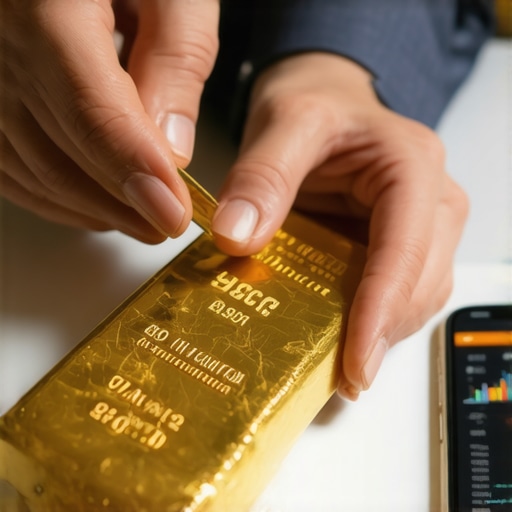Understanding the Importance of Gold Investments
In today’s financial landscape, gold remains a highly sought-after asset for both seasoned investors and newcomers alike. Investing in gold can serve as a hedge against inflation, a safeguard during economic instability, and a means to diversify one’s investment portfolio. However, many aspiring investors may find themselves asking, “How do I buy gold wisely?” This guide aims to provide key insights that can help you navigate the complexities of gold investment.
Types of Gold Investments to Consider
Before diving into the buying process, it’s essential to understand the different types of gold investments available. These include:
- Physical Gold: This includes gold coins, bars, and jewelry. Physical gold is tangible and can provide a sense of security for investors.
- Gold ETFs: Exchange-Traded Funds (ETFs) allow investors to buy shares that represent ownership in a pool of gold assets without the need to store physical gold.
- Gold Mining Stocks: Investing in companies that mine gold can offer exposure to gold prices while potentially providing dividends.
- Gold Mutual Funds: These funds pool money from multiple investors to invest in various gold-related assets, offering diversification.
Each type of investment comes with its own set of risks and rewards, and understanding these can help you make informed decisions.
Key Considerations When Buying Gold
When you’re ready to purchase gold, there are several critical factors to consider:
- Market Trends: Stay informed about current gold price trends by analyzing historical data and future forecasts. For insights, check out our post on gold price trends.
- Storage and Security: If you opt for physical gold, consider the storage options and security measures necessary to protect your investment.
- Authenticity: Always ensure that your gold is sourced from reputable dealers and comes with proper certifications to avoid counterfeit risks.
- Investment Goals: Define your investment goals clearly—whether you seek short-term gains or long-term wealth preservation, your strategy will differ accordingly.
For a deeper understanding of gold market dynamics, you can explore our article on how economic shifts impact future gold prices.
Conclusion: Making Informed Decisions
Buying gold wisely involves more than just purchasing the metal. It requires a comprehensive understanding of market conditions, types of investments, and strategic planning. By educating yourself on these key insights, you can enhance your investment strategy and navigate the gold market with confidence. Whether you’re a beginner or looking to refine your approach, let these insights guide your journey into the world of gold investments.
Evaluating Gold Investment Options
As you dive deeper into the world of gold investments, it’s crucial to evaluate which options align best with your financial strategy. Understanding the nuances of various gold investment vehicles can significantly impact your returns. Whether you choose physical gold, gold ETFs, or gold mining stocks, each has unique characteristics worth exploring.
Physical Gold: The Tangible Asset
Investing in physical gold offers a sense of security that is unparalleled. However, it comes with its own challenges, such as storage costs and potential insurance requirements. When purchasing physical gold, prioritize reputable dealers and ensure you receive proper documentation to verify authenticity.
Gold ETFs: A Convenient Alternative
Gold ETFs provide an accessible way to invest in gold without the hassle of storing physical assets. By purchasing shares of these funds, you’re effectively investing in gold at current market prices. This option is particularly appealing for those who prefer a less hands-on approach to investing. For more insights into navigating gold ETFs, explore our guide on how to invest in gold ETFs.
The Role of Gold in Your Investment Portfolio
Integrating gold into your investment portfolio can be a strategic move to enhance diversification. Gold often behaves differently than stocks and bonds, making it an effective hedge against market volatility. Understanding the role gold plays in your overall strategy is essential.
Hedging Against Inflation
Gold has historically been viewed as a safe haven during periods of economic uncertainty and inflation. When you invest in gold, you’re not just buying a commodity; you’re also securing a hedge against the diminishing purchasing power of currency. To understand this concept better, check out our post on gold as an inflation hedge.
Diversifying Your Investment Strategy
Diversification is a cornerstone of sound investing. By adding gold to your portfolio, you can reduce overall risk and improve potential returns. Many experts recommend allocating a certain percentage of your investment to gold, depending on your risk tolerance and investment goals. For practical advice on how to effectively diversify your portfolio, visit our article on gold investment strategies.
Market Insights: Staying Informed
To make an informed decision when buying gold, it’s essential to stay updated with market trends and forecasts. Monitoring gold price fluctuations and understanding factors that influence these changes can provide a competitive edge. For comprehensive market analysis, our article on gold market analysis can offer valuable insights.
Understanding Economic Indicators
Economic indicators such as interest rates, inflation rates, and geopolitical events can significantly impact gold prices. Keeping an eye on these indicators will help you make timely decisions in your investment journey. For a thorough breakdown of how these factors interact with gold pricing, delve into our post on how economic shifts impact future gold prices.
Conclusion: Strategize Your Gold Investment Journey
In summary, buying gold requires careful consideration, research, and strategic planning. With the right knowledge and resources, you can navigate the complexities of gold investments effectively. Whether you’re interested in physical gold, ETFs, or mining stocks, each option offers unique opportunities. Stay informed, be strategic, and watch your investment portfolio flourish as you incorporate gold into your financial strategy.
Strategies for Successful Gold Trading
When it comes to gold trading, having a well-defined strategy can make all the difference in your investment performance. Understanding various gold trading techniques allows you to maximize your returns and minimize risks. Whether you are a seasoned trader or a beginner, refining your approach to gold trading is essential.
Technical Analysis: Charting Your Path
Utilizing technical analysis is pivotal in identifying market trends and making informed trading decisions. By studying historical price movements and patterns, traders can predict future price action. Many successful gold traders rely on indicators such as moving averages and Relative Strength Index (RSI) to guide their trades. For a deeper dive into effective trading methods, consider exploring our post on effective gold trading techniques.
Fundamental Analysis: Understanding Market Forces
While technical analysis focuses on price trends, fundamental analysis examines the broader economic factors that influence gold prices. Key indicators such as interest rates, inflation, and geopolitical stability all play significant roles in shaping the gold market. By staying informed about these factors, you can position your investments more strategically.
Exploring Different Gold Investment Vehicles
As you consider investing in gold, it’s essential to explore various investment vehicles that suit your financial goals. From gold mutual funds to gold mining stocks, each option presents unique advantages and challenges.
Gold Mutual Funds: A Diversified Approach
Gold mutual funds offer a diversified investment option by pooling resources from multiple investors to invest in various gold-related assets. This approach reduces risk and provides exposure to a broader range of opportunities. If you’re interested in understanding the potential of gold mutual funds, check out our article on the benefits of gold mutual funds.
Gold Mining Stocks: Tapping into Potential Growth
Investing in gold mining stocks can be a lucrative strategy, especially as the demand for gold continues to rise. These stocks provide exposure to the operational success of mining companies, which can lead to significant returns. However, it’s crucial to evaluate the risks associated with mining stocks, including operational costs and market volatility. For insights into this aspect, our post on the risks and rewards of gold mining stocks can be beneficial.
Staying Ahead: Monitoring Gold Market Trends
Keeping abreast of gold market trends is vital for any investor looking to capitalize on opportunities. Regularly analyzing market data, reports, and forecasts will enable you to make informed decisions and adapt your strategies accordingly.
Understanding Gold Demand Trends
Gold demand can fluctuate based on various factors, including consumer behavior, industrial usage, and investment trends. By understanding the nuances of current trends driving gold demand, you can better anticipate market movements and adjust your investment strategy.
Conclusion: Elevating Your Gold Investment Game
In conclusion, successfully navigating the gold investment landscape requires a combination of strategic planning, market awareness, and an understanding of various investment vehicles. By employing effective trading strategies and staying informed about market trends, you can position yourself to optimize your gold investments. As you continue your journey into the world of gold, remember that knowledge is your greatest asset.
Advanced Strategies for Gold Investment
As you delve deeper into gold investment, exploring advanced strategies can significantly enhance your portfolio’s performance. Understanding the gold market dynamics and applying sophisticated investment techniques can be the key to successful trading.
Hedging with Gold: Protecting Your Investments
Hedging is a strategy used by investors to reduce potential losses in volatile markets. By investing in gold, you can hedge against economic downturns and inflation. Gold often acts as a safe haven during periods of uncertainty, making it an excellent choice for risk management. For a comprehensive look at how gold can serve as a hedge against financial crises, explore our article on gold as a hedge against financial crises.
Utilizing Gold ETFs for Flexibility
Gold Exchange-Traded Funds (ETFs) are an effective way to gain exposure to gold without the complexities of physical ownership. They offer liquidity and flexibility while tracking the price of gold closely. This investment method allows you to buy and sell shares throughout the trading day, providing opportunities for tactical trading. To understand how you can maximize your returns from gold ETFs, check our guide on maximizing gold ETF returns.
Understanding Market Sentiment: The Psychology of Gold Investing
The psychology of investors plays a significant role in the gold market. Market sentiment can lead to price fluctuations based on fear or greed, often independent of fundamental values. Keeping tabs on investor sentiment can provide insights into potential market movements. Tools such as the Commitment of Traders (COT) report can help gauge market sentiment and guide your trading decisions.
Analyzing Geopolitical Events and Their Impact
Geopolitical events often influence gold prices dramatically. Tensions, conflicts, and elections can create uncertainty, driving demand for gold as a safe-haven asset. Staying informed about global affairs and understanding their implications on the gold market is crucial for making informed investment decisions. For more insights into how geopolitical events impact gold prices, take a look at our post on the impacts of geopolitical events on gold prices.
Conclusion: Empowering Your Gold Investment Journey
In summary, advancing your gold investment strategy involves a blend of risk management, market analysis, and understanding investor psychology. Whether you are using hedging techniques, investing in ETFs, or analyzing geopolitical factors, each element plays a crucial role in optimizing your gold investments. By continuously educating yourself and adapting to market changes, you can enhance your investment journey in the world of gold.
Frequently Asked Questions about Gold Investment
What is the best way to invest in gold?
The best way to invest in gold depends on your financial goals and risk tolerance. You can choose from physical gold, gold ETFs, mutual funds, or even gold mining stocks. Each option has its advantages and disadvantages, so consider your investment strategy carefully.
Is investing in gold a good idea?
Investing in gold can be a good idea as it serves as a hedge against inflation and economic uncertainty. Gold often retains value during market downturns, making it a safe haven for many investors. However, it’s essential to evaluate your individual circumstances and market conditions.
How do gold prices fluctuate?
Gold prices fluctuate based on various factors including supply and demand dynamics, geopolitical events, inflation rates, and currency strength. Keeping a close eye on these indicators can help you anticipate changes in gold prices.
Can I invest in gold through my retirement account?
Yes, you can invest in gold through a self-directed IRA or 401(k) that allows for precious metals investments. This method provides tax advantages while diversifying your retirement portfolio.
What are the tax implications of selling gold?
When you sell gold, you may be subject to capital gains tax. The tax rate depends on how long you’ve held the gold and its classification. It’s advisable to consult with a tax professional to understand your specific tax obligations.
How much gold should I include in my investment portfolio?
Financial experts typically recommend allocating 5-10% of your portfolio to gold as a hedge against market volatility. However, your allocation should align with your risk tolerance and investment goals.
What are the risks of investing in gold?
The risks of investing in gold include price volatility, lack of income generation, and potential liquidity issues. Understanding these risks can help you make informed decisions and manage your investment effectively.
How do I buy physical gold securely?
To buy physical gold securely, purchase from reputable dealers, verify authenticity, and consider using a safe storage option. Always do thorough research before making any purchases.
Are gold ETFs a safer investment than physical gold?
Gold ETFs are generally considered safer for investors looking for liquidity and ease of transaction without the concerns of storage and insurance associated with physical gold. However, they do not provide the same tangible asset benefits as owning physical gold.
What is the future outlook for gold investment?
The future outlook for gold investment remains optimistic due to ongoing economic uncertainties, inflation concerns, and geopolitical tensions. Investors are likely to continue turning to gold as a reliable store of value.
Authority Resources for Gold Investment
To further educate yourself on gold investment, consider exploring the following trusted resources:
- Investopedia – Gold Investment Guide: A comprehensive resource for understanding gold as an investment.
- Kitco – Gold & Silver Prices: Provides real-time pricing, charts, and market analysis for gold and other precious metals.
- World Gold Council: Offers extensive research, insights, and data on gold investment trends and market dynamics.
- BullionVault: A platform for buying and selling physical gold and silver, along with educational resources for investors.
- CNBC – Gold Market News: Stay updated on the latest gold market news and analysis from a trusted financial news source.
Conclusion: Navigating Your Gold Investment Journey
Investing in gold can be a rewarding venture when approached with the right strategies and knowledge. By understanding the market dynamics, employing advanced investment techniques, and staying informed through reliable resources, you can effectively navigate your gold investment journey. Whether you are a novice or an experienced investor, the insights provided in this guide will empower you to optimize your gold investments and achieve your financial goals.











I’ve been fascinated by the role gold plays as both a financial safety net and an investment asset. This post really highlights how understanding the different forms of gold investment is crucial—especially the contrast between physical gold and gold ETFs. From my experience, physical gold offers that tangible reassurance, but the storage and security concerns aren’t trivial and can quietly add to costs. On the other hand, gold ETFs provide the liquidity and convenience that can suit a more active investor or someone who prefers a hands-off approach. One point that resonated with me was the emphasis on investment goals—short-term gains versus long-term wealth preservation truly change the approach you should take. I’m curious how others balance these goals, especially when economic indicators like inflation start fluctuating unexpectedly. Do you prioritize physical gold for a long-term hedge, or do you lean into ETFs or mining stocks to capture potential growth? It’s definitely a nuanced decision that varies depending on individual risk tolerance and market outlook. How has your own strategy evolved as you’ve gained more insight into gold market dynamics?
This post sheds light on the nuanced aspects of gold investing, especially highlighting how significant your investment goals are in shaping your approach. I’ve personally found that diversifying between physical gold and ETFs can be quite effective—physical gold offers a tangible sense of security, particularly during economic crises, while ETFs provide easier liquidity for active trading. One challenge I’ve encountered is deciding how much of my portfolio should be allocated to gold to balance safety with growth potential, especially since market trends can shift unexpectedly. I appreciate the emphasis on understanding market trends and economic indicators, as those have directly impacted my decision-making process over the years. For instance, during recent inflation spikes, I leaned more toward physical gold as a hedge, but I continue to diversify with ETFs for liquidity. How do others decide when to shift from paper gold to physical, especially during volatile markets? It’s definitely a balancing act and I’d love to hear strategies that have worked for different investors, whether long-term or short-term focused.